Menu
- About
- Courses
Kweller Prep Courses
- Tours
- Media
- Contact Us
Home » Tutoring Services » HUNTER
Select a course below, select your preferred session type and class schedule. You will be guided through the checkout process.
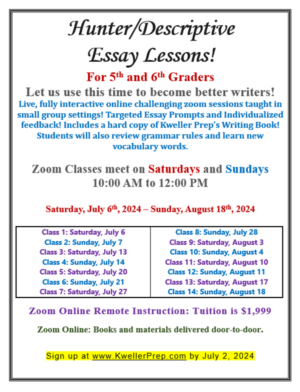
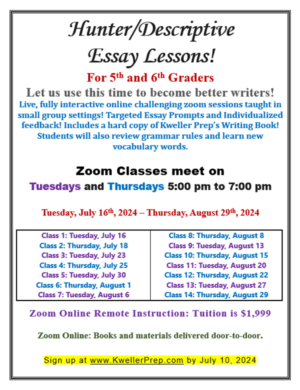
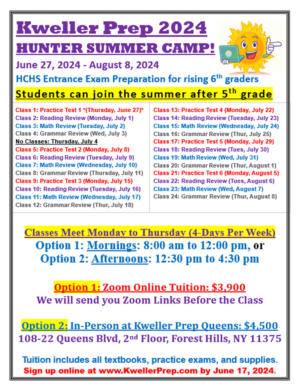
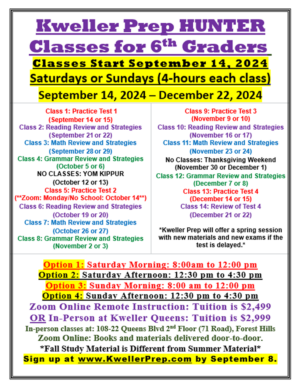
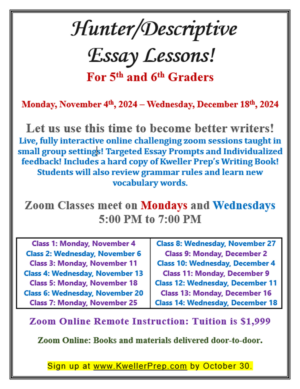
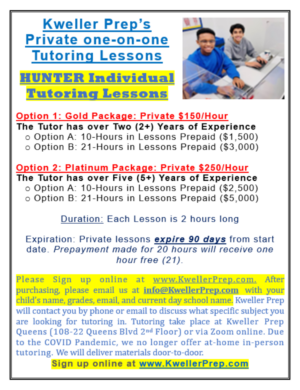
2024 HCHS Entrance Exam
Eligibility and Application Process
Hunter College High School (HCHS):
The Hunter College High School Entrance Exam — for Seventh Grade entry in Fall 2024 — will be administered on Wednesday, January 24, 2024.
The minimum scores needed to qualify for the HCHS Entrance Exam are as follows:
NYS ELA Exam: 479+
NYS Math Exam: 492+
Please visit the “Eligibility” section of the site for information on all other forms of eligibility.
The admissions application for Hunter College High School (HCHS) will open on Friday, October 27 at 4:00pm.
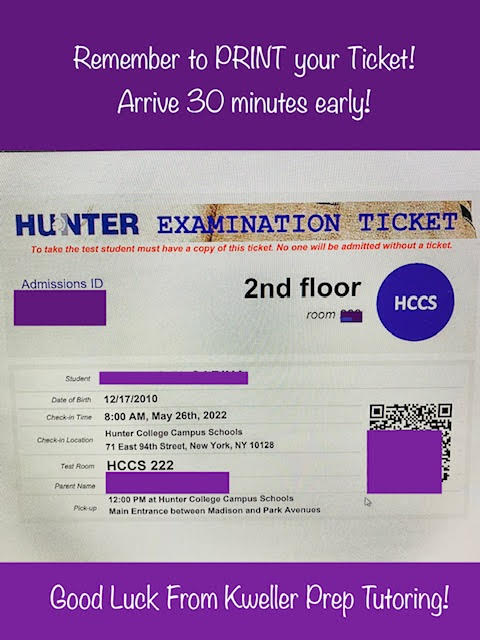
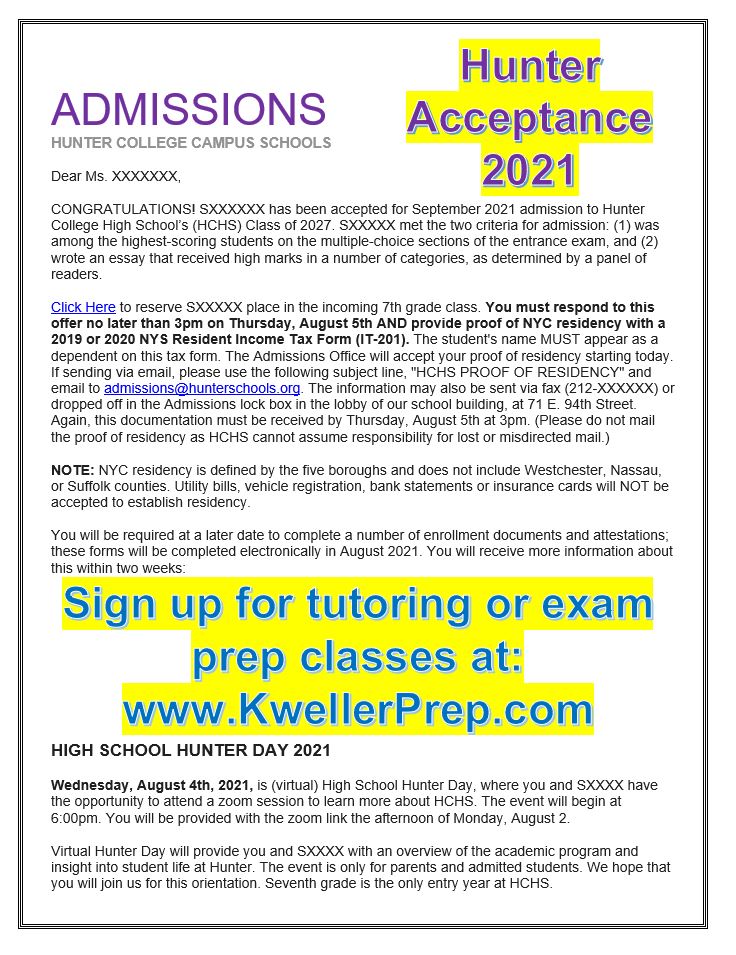
The Team at Kweller Prep would like to thank the parents, students, tutors, and support staff who, collectively, made this program’s success possible. Kweller Prep has the highest hunter acceptance rate from any program in NYC. Make no mistake, our outstanding results came from incredible collective sacrifice, team effort, and coordination from all parties involved; parents, tutors, students, and essay graders. Parents, please cooperate while your child is enrolled. Make sure your child is completing all homework assigned and reach out to us at info@Kwellerprep.com if extra help is needed.
Disclaimer: Kweller Prep does not guarantee admission to any school. Kweller Prep is a tool and we provide infrastructure throughout our challenging program. It is critical to your child’s success that they complete all Kweller Homework and assignments at home in an undistracted manner. With that in mind, Kweller students are expected to allocate 2-4 hours per week starting September to review and practice Kweller packets. Parents are asked to minimize outside extra-curricular activities throughout the duration of our prep course and leave a very specific time each week to practice our Hunter-like test questions. Please understand and respect our limitations prior to making your decision to commit to our program. Tuition is nonrefundable and results are not guaranteed.
I. From 120 students who enrolled in Kweller Prep in September 2018, 35 students from Kweller Prep were accepted to Hunter!
II. On January 10, 2019, 2,812 students took the Hunter Test in total. There were 3,490 sixth grade students invited to take the Hunter Test. 473 more students tested in 2019 than in 2018. final number = 2,812
III. The Multiple Choice cut-off was not announced in 2019, largely due to the political climate and tensions with the NYC Mayor and the SHSAT. Coupled with disgruntled parents wrongfully questioning the school about the metrics of the test, Hunter made a firm decision to not release exact cut-off scores to any families this year.
IV. Hunter released no data as to exactly which students had their essays read or which ones met the multiple-choice cut-off. Again, the school implemented a policy change in 2019 reaction to issues with parents and the political landscape of the SHSAT.
V. Only the top 500 Multiple Choice scores had their essays read.
VI. 5 Kweller Prep students were placed on the Hunter waitlist.
VII. The overall acceptance rate to Hunter is less than 6%.
IX. Kweller Prep’s acceptance rate to Hunter is 29.16%
*Update 4/15/2019: Our acceptance rate is higher than what is posted. Several students were removed from the waitlist after attending Hunter’s Welcome Day. Several more parents updated us the week following the Hunter results. 2019 was our most successful acceptance year to date.
Welcome to the Hunter entrance exam. We know this is a very important day for you and we want to make sure that you feel totally prepared.
Everyone wants to get to the test on time, but stay relaxed. There is no advantage to being first on the line – all students are already assigned rooms. You won’t be allowed to enter the test building until 8:00 AM so you don’t need to arrive before 7:00 AM, especially since you’ll be waiting on line outside in the cold! Make note of the entrance time on your admittance ticket – this is the time that you should be at the entrance for the test.
You should dress in layers on test day. Test rooms can be chilly or quite warm; you may want to be able to take off a sweater and be more comfortable in a T-shirt if necessary.
Only one of your parents can come with you on test day. Parents will not be permitted to enter the test site with you, or to wait inside while the test is going on. The first time they can enter is 11:30 AM when they are allowed in to wait at the dismissal locations.
When you are inside your testing site, you will be directed to the test room indicated on your admission ticket.
If you have a cell phone it must be turned off. Your proctor will give you an envelope to put it in that you will label with your name. It will remain with the proctor for the duration of the test. This is to ensure that there is no cheating and that the test is not interrupted.
Place your admissions ticket on your desk where the proctor can see it. Your admissions Candidate ID Code number is on the exam ticket. Remember the 4-digit code; you will need to record it on your test booklet cover and written composition as the Admission ID number.
You will be given your test booklet and a “bubble” answer sheet. You will fill in your name and other information to prepare the answer sheet. Make sure to bubble in all the information correctly!
Throughout the test, the proctor will write the time and how much time is remaining on the chalk board so that you can be aware of how much time you have left to complete the test. You have three hours for the entire exam. You will not be told to stop until the end of the test. Consider your own strengths and how much time you can allow yourself to spend on each section. You will need to monitor the time and pace yourself. It is best if you do the exam in the order that the sections appear in the test booklet.
Some students have asked if they can do the mathematics section before the Writing Assignment. We have specifically placed the writing assignment after the reading passages and have designed the test to go December 2013
in the order it was written. You may choose to do the exam in any order you wish, but we strongly recommend that you follow the order that we have designed.
The HCHS exam is designed to assess your learning. No one test can give a complete picture of your skills and knowledge, but the exam will provide a sample of your thinking, comprehension, creativity, and problem solving ability.
The cover page of the test has spaces for you to print and sign your name and your birth date and to write the admissions code that is on your ticket for the Entrance Exam.
This test contains three sections: 50 multiple-choice English Language Arts questions, a Writing Assignment, and 30 multiple-choice Mathematics questions.
Each multiple choice question is followed by five possible answers: A, B, C, D, or E. Choose the best answer for each question. You may make marks in this test booklet; use the space between questions and the blank pages in your booklet for scrap paper. There is no penalty for guessing.
On the answer sheet, carefully blacken the circle that contains the letter of the answer you select. Use only a Number 2 pencil for the multiple choice sections. If you wish to change an answer, carefully erase the wrong answer completely and mark your new answer. As soon as you finish one section of the test, go on to the next section. Monitor the time the proctor writes on the board.
Calculators are not permitted
The topic of the Writing Assignment is on page 15. Scrap paper for the writing assignment is provided on page 16. If you use the scrap paper, be sure to copy your entire writing assignment onto page 17. You do not need to include a title. You may use pen or pencil for the writing assignment.
You have a total of three hours to complete the examination, including the writing assignment.
If you complete the test before the time is up, you may review your previous work to correct for errors. Make sure that your answer sheet is accurately and cleanly prepared.
You may not remove any page from this booklet or take papers from the test room.
In the Critical Reading section your reading comprehension will be assessed. You will answer questions about specific reading passages to show your ability to understand, interpret, and analyze a number of types of writing.
When you are instructed to do so, you will turn to page 1 inside the booklet and look at this section of the test. Critical Reading contains six passages to read. There are multiple-choice questions after each passage.
The passages in the Critical Reading section are all different, reflecting different types of writing. You will read six passages of varying lengths. Each is followed by multiple choice questions about it. Every fifth line of each passage is numbered so that you can find the part the question refers to. You are asked to read the passage and answer the questions based on the content of the passage.
It is important to manage your time: monitor your progress when the proctor makes a new time notation on the board.
You will write either an essay or an autobiographical piece (up to two pages) to assess the originality, effectiveness, and use of detail in your writing. There is scrap paper in the test booklet where you can jot down, outline thoughts, or compose a draft before writing the full assignment.
You will write the full assignment on the lined composition paper that is on a perforated page of the test booklet. Do not separate the page from the booklet. The readers of your writing will read only what you have written on the perforated page.
Complete the Writing Assignment on the lined paper on page 17. If necessary, you may continue on to page 18. Only pages 17 and 18 will be read by the evaluators.
Do NOT detach the Writing Assignment from the test booklet.
You do not need to include a title.
You may use pen or pencil.
Make sure that your Exam Booklet Number and Admissions ID Code are written clearly at the top of pages 17 and 18.
Do NOT write your name on the Writing Assignment.
When you complete the Writing Assignment, you will see the directions on the page to continue on to the Mathematics section.
This section tests your problem-solving ability. Students solve a variety of problems, including multi-step ones involving: estimation; computations with fractions, decimals, percents, and whole numbers (not negative numbers); rules of divisibility; simple probability; rate; average; ratio; time; money; area of shaded regions; perimeter; counting; visual and numerical pattern recognition; and three dimensional figures.
The Mathematics section is made up of 30 multiple choice questions, each of which is followed by five possible answers: A, B, C, D, or E. You will choose the best answer from the possibilities given for each question.
There is scrap paper and room to do your figuring in the test booklet. Take advantage of the space to test out your thinking. Extra paper may not be brought into the test room and calculators are not permitted.
If you finish the exam and there is still time left during the testing session, it is a good idea to check your responses, and look over your writing assignment. When checking your answer sheet, make sure that you have erased any stray marks and clean up all places you’ve erased so that your answer sheet can be read correctly. Make sure that the answer you have bubbled in matches the answer you have selected for the question.
The proctor will give you the directions for the proper collection of the booklets and answer sheets. You will not be permitted to take any papers away from the exam.
The proctor will give you the dismissal directions. Your parent/guardian has your pick up location and will be there to meet you when you are done. It will be easy to find your parent at the dismissal location.
The exam is done! You should feel very proud of yourself – you’ve been a great student and you’ve done your best on a competitive exam. Though it seems like a long time to wait, you’ll hear back from Hunter in mid-March. Until then, keep up the good work and give yourself hearty congratulations for making it through the Hunter test!
Remember, this essay is often written written without the “I” although you can be subjective. If you can find no other way to NOT refer to yourself, use the phrase “this writer” or “the author”, as in “this writer walked down the path of the park and almost tripped….” Use this method ONLY IF there is simply no other way to show you very specifically are affected by something as an other. Otherwise use “one” or other ways to write. We’ll discuss how to do this.
If you love to people watch and watch the world go by when you are in the train, cafes, or walking around, this might be a very fun essay for you. Use your “nosiness” to your advantage with this essay. Description – what it is: Description tells the reader about the physical characteristics of a person, place, or thing. Generally, description relies upon the five senses: sight, hearing, taste, touch, and smell. In rhetoric, description is fundamentally concerned with dominant impression: through the arrangement of details, the writer emphasizes the mood or quality of a thing. The thesis or central point of a descriptive essay is supported by the use of words that work to convey your dominant impression of a person, place, or thing.
Descriptive essay and our theme of New York, place/home, neighborhoods: Topic suggestions and guidance for picking your own topic: Here’s further explanation on this topic and what options exist with it. There are several variations on this topic you can use, this is just the main one. Read on for several possibilities you can think about and then narrow down to your own specific preference. These are ideas to get you started on focusing on a topic. Brainstorm some topics down on paper. With inspiration from E.B. White’s “Here is New York” and our forthcoming readings on Maeve Brennan “the Long Winded Lady”, how would you describe aspects of New York’s unique qualities with inspiration from the way E.B White has? Make sure this is totally different from your first essay. But perhaps you touched upon something very briefly in your first essay that you might want to explore in a descriptive essay.
Another variation to think about it is: with inspiration from E.B. White and Maeve Brennan, write about a single street, walk, shop, person/character or specific part of a neighborhood you know well and how it’s changed, stayed the same or both. You will rely on observation but you can also incorporate some outside sources if you want to. The overall idea of this topic is writing with good details about a specific place in NY and its interesting or quirky characteristics, or to write an overall piece that is about NYC or Brooklyn’s or any other borough’s unique characteristics, in the way EB White wrote about it.
Description, in trying indirectly to convey your response, will depend upon figures of speech to sharpen your using subjective language. Simile, metaphor, personification, and allusion are essential tools for crafting subjective description.
Description, whether objective or subjective relies upon detail. Your aim in description is not to tell the reader something, but to show it. Whether objective or subjective, you need to select details and words which convey your dominant impression.
I. Arriving at a the main idea: What are the details? In what order should the details appear so they support your thesis and narration/story/main idea? Should you move from a specific to a general description of the subject? Should you move from the least important to the most important feature? What is your thesis? Your purpose? Your audience? Specific details are important for the descriptive essay.
II. Selecting and arranging the details: As you move through the description you must keep aware of your use of descriptive words and work at maintaining the flow of your description. Keep in mind the overall movement of your essay tailor it to work with the flow by not focusing description that will distract the reader.
III. Formulating the thesis statement Your thesis should convey your main idea while it also points in the direction your descriptive essay will take. The sequence of events is an essential consideration in formulating your thesis.
Formatting the Essay: here, you orient your reader by stating your thesis and by using your main idea details to create a mood in which you will write the descriptive essay.
Body – here, you rely upon interesting details and logical sequencing for events and the use of chronology or transitions to keep your reader connected to the purpose of your essay.
Conclusion – restate the thesis or review key points and the important details.
Dear Parent:
On January 8th, 2016, Your child and 2,221 other 6th graders took the Hunter College High School(HCHS) Entrance Exam. They studied hard, waited in the cold, sat for three hours, and worked through a tough exam of English, Writing, and Math.
Unfortunately, we are not able to offer Your child a seat in the HCHS Class of 2022. In keeping with our admissions procedures, we have offered admission to the students who met two criteria: (1) were among the highest scoring students on the multiple-choice sections and (2) wrote the most highly scored essays as determined by the panel of readers. Your child obtained a total of 56 out of a possible 100 points. Only the essays of those students whose multiple-choice score totaled 60 points or above were submitted to the essay judges. Your child’s essay was not evaluated for admission.
Please note that HCHS has a strict policy of not releasing any portion of the examination to anyone; this includes the applicants and their parents. We do not review or reconsider individual exam or essay scores.
While we know that you may be disappointed, please remember that your child is among the top students in New York City. Fifth grade test scores that qualified for the Entrance Exam are extremely competitive. Hunter is only one option for middle and high school; application for spots at the New York City Specialized High Schools and other top options lie ahead. Your child met this challenge with purpose and determination and is sure to find success in the future.
We wish the best of luck to you and your child.
Sincerely,
Jana Lucash
Acting Director of Admissions and Outreach
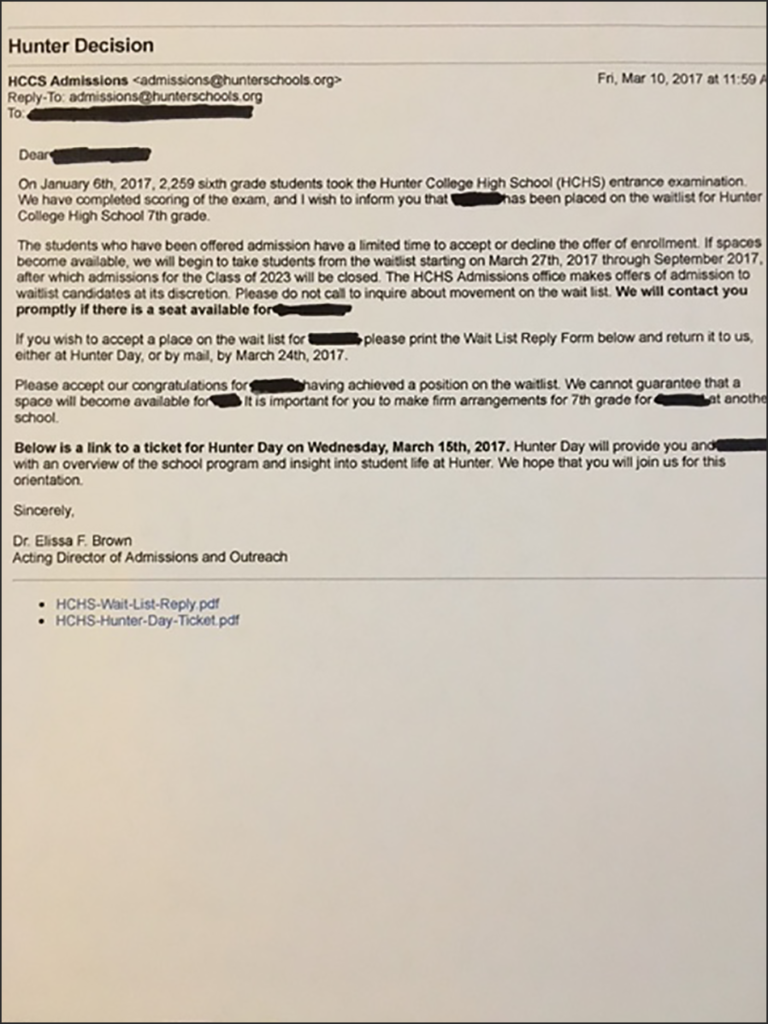
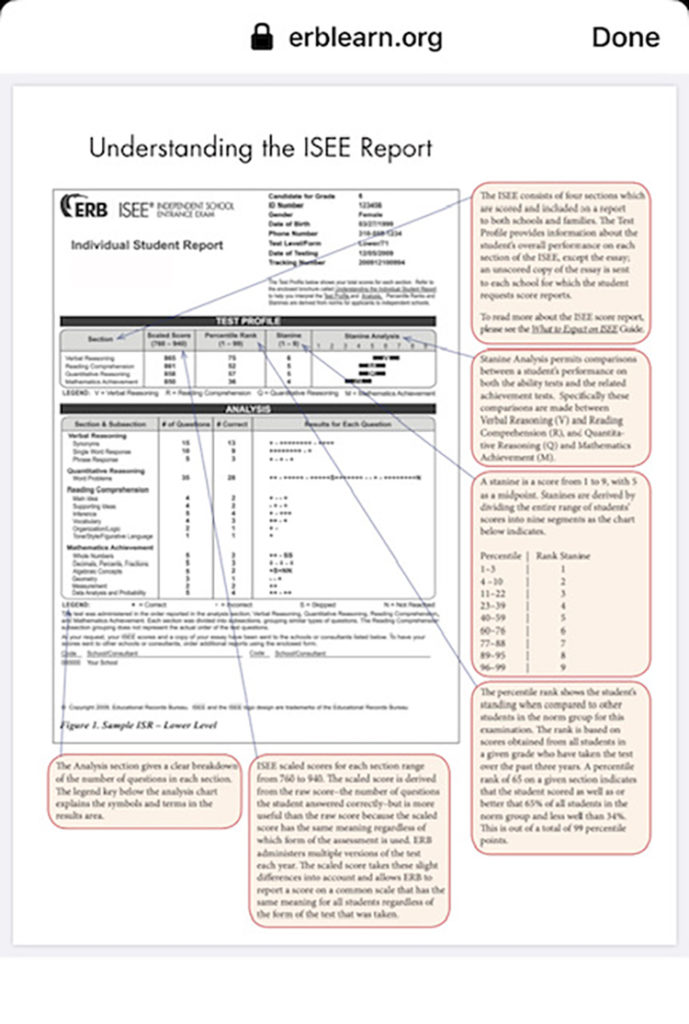
Disclaimer: Kweller Prep Programs are not refundable. Read our policies and procedures here.
Copyright © 2021 KwellerPrep. All rights reserved.
Home
About
Blog
Donations
Meet The Tutors
Become a Tutor
Media
Books
College Essay Drafting
College Tours
High School Tours
Summer Camp
Personality Testing
ACT Prep
Anderson Prep
AP Exam Prep
Baccalaureate Exam Prep
BARD H.S. Interview
Cambridge Assessments
Computer Science
ELA Math
Hunter High School Exam
ISEE Test Prep
John Hopkins CTY Prep
LaGuardia Art Portfolio
LSAT and GRE Exam Prep
MCAT Prep
Model United Nations
Nest Prep
Private/Skype Tutoring
PSAT Exam Prep
Regents Exam Prep
Scholars Academy
SAT Exam Prep
SHSAT Exam Prep
Speech and Debate Prep
TACHS Exam Prep
Talented and Gifted
Terra Nova Exam Prep
Kweller Admissions Testing
Kweller Day School
Kweller June School
Kweller Prep Reviews
Kweller Prep Book Club
Policies and Procedures
Disclaimer
Queens Location
Manhattan Location
Directions
Contact Us
Sitemap